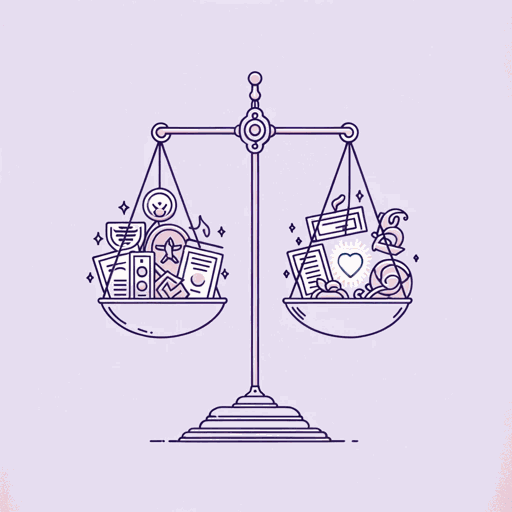33 pages • 1 hour read
David BrooksThe Moral Bucket List
Nonfiction | Essay / Speech | Adult | Published in 2015A modern alternative to SparkNotes and CliffsNotes, SuperSummary offers high-quality Study Guides with detailed chapter summaries and analysis of major themes, characters, and more.
Summary and Study Guide
Summary: “The Moral Bucket List”
“The Moral Bucket List” is an essay by David Brooks first published in the New York Times Op-Ed Section on April 11, 2015. Born in Toronto and raised in New York, Brooks is a prominent cultural journalist, political analyst, and book author. Since 2003, he has written a twice-weekly column for the New York Times, and since 2004, he has been a political analyst for PBS NewsHour. “The Moral Bucket List” is an adapted excerpt from his 2015 book The Road to Moral Character (Random House). The essay explores themes such as Living a Meaningful Life, The Journey of Moral Development, The Tension Between External Achievement and Internal Character, and The Self in the World.
Brooks opens the essay by explaining that he encounters someone who “radiates inner light” about once a month (Paragraph 1). These “deeply good” people “listen well” and exhibit grace, generosity, and gratitude, making those around them feel valued. When Brooks encounters these people, they make his whole day better. He admits, though, that while he has achieved some professional success, he lacks the character and integrity of such people.
Brooks wants to be more like the people who radiate inner light and reflects on the difference between “resume virtues,” skills that are valued in the marketplace, and “eulogy virtues,” traits that people extol at funerals, such as bravery and kindness. Though the eulogy virtues are more important for living a meaningful life, Brooks asserts that “modern American culture and education spends time teaching us about the resume virtues but leaves the eulogy virtues unexplored” (Paragraph 4). He proceeds to discuss the drawbacks of living for external achievement, which leaves unexplored the deepest and most important pieces of the self. People who live predominantly for the resume virtues miss out on the most transcendent joys.
Having identified himself as someone who needs more balance between external and internal development, Brooks embarks on a journey to learn how people with an inner light acquire their deep goodness. He concludes that moral goodness is built over time. He drafts a moral bucket list enumerating some of the experiences that foster the “richest possible inner life” (Paragraph 5). For each entry on his list, he provides an example or a thorough description.
The first item on Brooks’s moral bucket list is the “humility shift.” Although modern American culture celebrates perfection, everyone whom Brooks truly admires is aware of their weaknesses. People with an inner light are strikingly honest about their “core sin,” the behavior that arises from their core sin, and the shame that stems from that behavior. This knowledge is the basis of a “profound humility” for these individuals who understand their limitations and objectively see their place in the world.
The next item on the list is “self-defeat.” If the “humility shift” entails comprehending one’s core weakness, self-defeat entails confronting and mastering it. Brooks argues that “character is built during the confrontation with your own weakness” (Paragraph 12). He provides the example of Dwight Eisenhower, who recognized that his primary fault was anger. Eisenhower spent a lifetime learning how to control his temper by facing it and devising strategies for channeling or diffusing it.
Next on Brooks’s moral bucket list is the “dependency leap.” Whereas modern American culture sees life as a journey of autonomous self-mastery, people who live purposeful lives commit themselves to emotional connections and intellectual pursuits. Brooks references the custom of giving recent college graduates the Dr. Seuss book Oh the Places You’ll Go! which promotes the belief that people’s lives are stories of individual success. In contrast, people who radiate inner light understand that they are enmeshed in networks and embrace commitments to other people and institutions. They know that “character is defined by how deeply rooted you are” (Paragraph 14).
After the “dependency leap,” Brooks describes “energizing love.” He argues that genuine and profound love lifts us beyond self-centeredness, displacing the focus on the self and becoming the force behind commitments to serve. Brooks’s example is Dorothy Day, who initially led a life of alcohol abuse, self-loathing, and suicide attempts. Once Day’s daughter was born, however, she was so overcome with love for her child that she began to make weighty commitments to the world such as embracing Catholicism, starting a radical newspaper, and opening settlement houses for the poor.
Next on Brooks’s list is the “call within the call.” People choose professions for different reasons, such as money, security, and status, but for some people, their careers are driven by a calling to serve the greater good. Brooks presents the example of Frances Perkins. In the early 20th century, Perkins genteelly and politely defended progressive causes until she witnessed the Triangle Shirtwaist Factory fire. Watching workers jump to their deaths off the burning building sharpened her moral sense and ambition. Perkins became fiercely committed to the cause of workers’ rights and safety reform, willing to work tirelessly and push through barriers to achieve her goals. Eventually, her dedication led her to become the first female secretary of labor and member of a presidential cabinet.
The final entry in Brooks’s “moral bucket list” is the “conscience leap,” which describes a moment in people’s lives when they free themselves from the trappings of prestige and career and dive into the encounters that help them nurture their core selves. Brooks adduces as evidence the novelist George Eliot, whose birth name was Mary Ann Evans. In her young life, Evans threw herself into insubstantial relationships with men who rejected her. When she met George Lewes, he was still legally married; she knew that if she began a relationship with him, she would be labeled an adulteress and shunned by her friends and family. She chose Lewes anyway. In the end, Evans’s relationship with Lewes stabilized her, and she became one of the most celebrated authors in English literature.
Brooks acknowledges that the path he describes is not for the faint of heart. It is a path for “stumblers,” built on “a pattern of defeat, recognition, and redemption” (Paragraph 25). There are moments of pain and failure, but the stumbler turns these into opportunities for self-awareness. He paraphrases Lutheran theologian Paul Tillich, who writes that suffering introduces us to the most fundamental truths about ourselves. Brooks argues that in the process of confronting themself with unflinching honesty, the stumbler can surpass their limitations. They form bonds with other stumblers, and they are enmeshed in communities of advice, comfort, and support. Whereas those who pursue external achievement are never satisfied, the stumbler who balances external ambition with internal development feels moments of “deep tranquility […] When the ego rests, [they] look[] out at a picnic or dinner or a valley and [are] overwhelmed by a feeling of limitless gratitude, and an acceptance of the fact that life has treated [them] much better than [they] deserve[]” (Paragraph 29). Brooks closes the essay by reminding his reader that this is the kind of life he and they aspire to.
Related Titles
By David Brooks

Bobos in Paradise
David Brooks

How to Know a Person: The Art of Seeing Others Deeply and Being Deeply Seen
David Brooks

People Like Us
David Brooks

The Road to Character
David Brooks

The Second Mountain
David Brooks

The Social Animal: The Hidden Sources Of Love, Character, And Achievement
David Brooks

